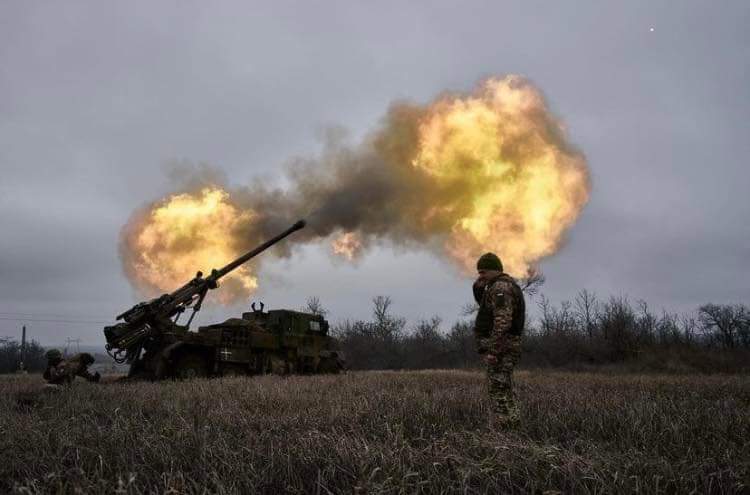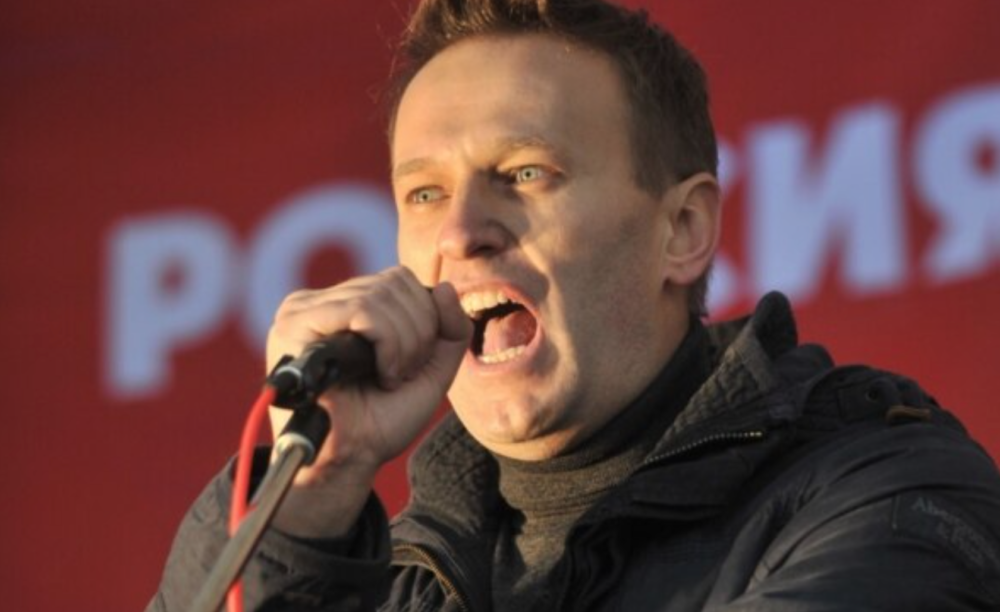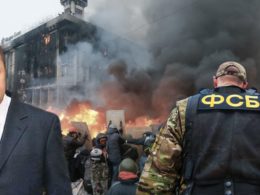During the full-scale invasion of Ukraine, Russian forces built a solid system of defensive fortifications on the eastern bank of the occupied parts of Kherson and Zaporizhzhia oblasts. The Russians seized these territories in the first weeks of their all-out war against Ukraine in the spring of 2022 and had enough time to dig several lines of defense. In particular, they intensified their work after Ukraine's successful offensive in Kherson and Kharkiv oblasts last fall.
Furthermore, the Russians did not have enough troops in the southern direction, as they were concentrated primarily on the eastern front near Bakhmut in Donetsk Oblast. And while Ukraine was repelling Russian attacks in and around Bakhmut, training new units, and waiting for Western military equipment to arrive, Russia built a strong line of defense in the South. The direction of the next Ukrainian attack after Kherson was clear. To understand the logic of the events, it is necessary to analyze the strategic plans of each belligerent.
Ukrainian and Russian strategic plans
For the Ukrainian army, the primary goal in this area (besides liberating the occupied territories) is to cut the so-called land bridge from Russia to occupied Crimea: through the major cities and logistics hubs of Mariupol, Berdiansk, and Melitopol in southeastern Ukraine.
Severing the land bridge would cut off hundreds of thousands of Russian troops on the Crimean peninsula and along the Dnipro River (on its eastern bank in southern and southeastern regions of Ukraine) from stable supplies. These supplies to invading Russian forces go all the way up into southern Ukraine through the Crimean bridge and ferry crossings in the Kerch Strait, which connect the Black Sea and the Sea of Azov, separating the Kerch Peninsula of Crimea in the west from the Taman Peninsula of Russia's Krasnodar Krai in the east.
The way and place of the land bridge cutoff are not that important. The task will be accomplished if Ukrainian forces liberate Melitopol, Berdiansk, or Mariupol. Suppose the Ukrainian army reaches the Azov Sea. In that case, the Crimean Bridge will also come under attack, and the entire Crimean-Kherson group of Russian forces will suffer from a lack of fuel and ammunition.
For the Russian army, the primary task is to hold its own defense lines. The Russians may also be tasked with improving their tactical and operational situation in eastern Ukraine and reaching the administrative borders of the Donetsk and Luhansk oblasts.
It is unlikely that Russia's military leadership is currently planning strategic offensive operations. Their main goal for 2023 is to hold on to the territories they have already seized, possibly improve their situation or make some territorial gains, and, of course, defeat the Ukrainian Army to force Ukraine to the negotiating table and, thus, freeze the conflict and gain time.
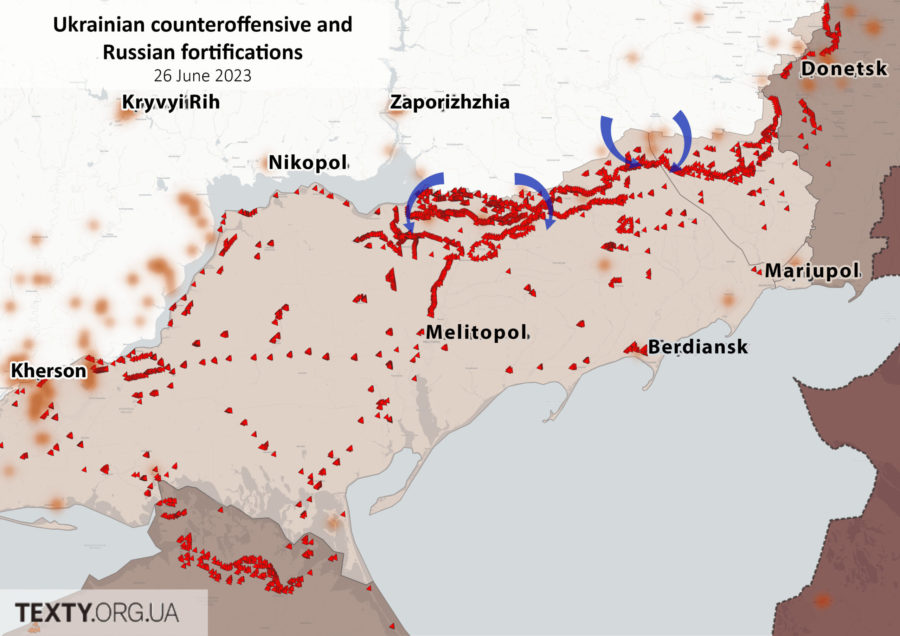
Axes of the Ukrainian offensive
On the southern front, Ukrainian defenders conducted active offensive operations in three directions: Melitopol sector - in the general direction of Orikhiv-Melitopol; Berdiansk sector - from Velyka Novosilka (so-called Vremivsky ledge); and Zaporizhzhia sector - along the Dnipro River toward the southwest.
In the Zaporizhzhia sector, the Ukrainian Armed Forces are gradually advancing from Piatykhatky southward to the Hrozove-Dolyna line and are gradually liberating the south of Kamianske. The Russian defense is perhaps the most powerful and best organized in this area.
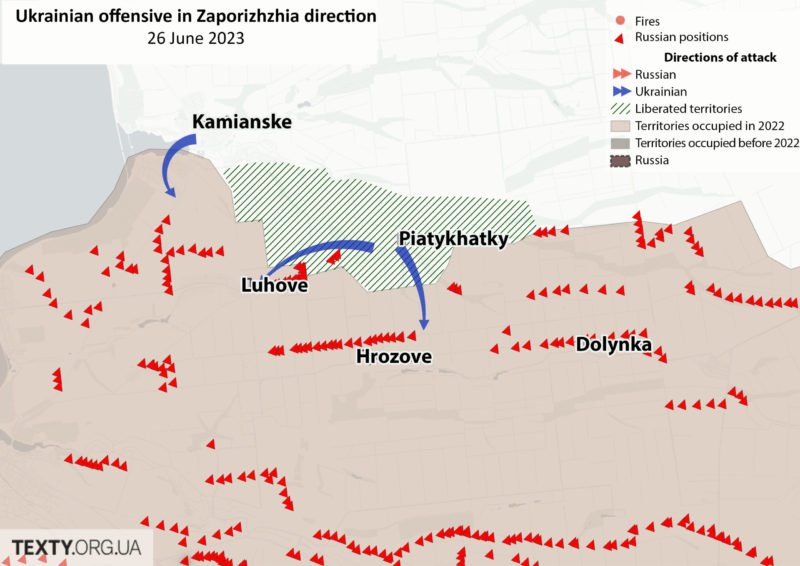
In the Melitopol sector, the Ukrainian forces are also advancing south, assaulting the Russian first line of defense and, in some places, even breaking through it. According to OSINT researchers, Russia has extensive defense lines in this area. The Ukrainian Armed Forces are close to approaching and attacking advanced Russian positions in the Melitopol sector.
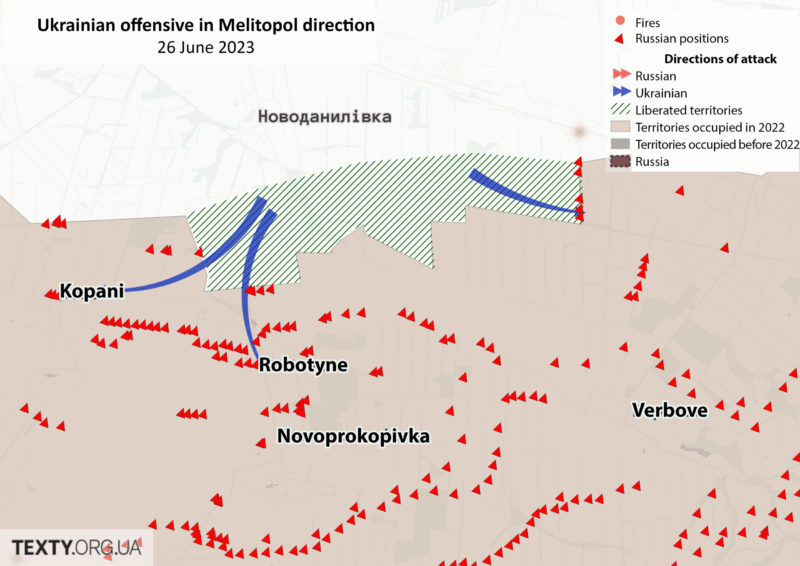
In the Berdiansk sector, on 26 June, Ukrainian forces liberated Rivnopil. This town was one of the Russian outposts that had been in a cauldron for several days, but as a result of the liberation of Novodarivka, the Vremivsky ledge (several occupied villages north of Staromaiorsk) was effectively cut off. The Vremivsky ledge was an advanced first line of defense that Russia's army could use as a springboard for the planned Russian offensive in the worst-case scenario for Ukraine. The most solid defense lines were located to the south.
In the area of Velyka Novosilka, the Ukrainian forces attacked Russian positions in Staromayorske and advanced toward Pryiutne.

Russian defensive lines
Russian troops have set up a deeply echeloned defense consisting of at least three lines and additional fortifications around key settlements. Their main strength is extensive minefields and the ability to plant mines remotely, even after the advancing Ukrainian forces have cleared a specific area of mines. For this purpose, the Russians use the Zemledelie mine-laying system. Another vital component of Russian defense is aviation: both airplanes and helicopters. Ukraine does not have enough means to destroy either of them effectively. F-16 fighter jets could be helpful here, as they would quickly take down Russian attack helicopters.
The Russian defense is based on these two critical components: aviation and mines. As numerous videos released by Ukrainian troops show, when it comes to clashes, the Russian military is not always well-trained and often poorly motivated. At the same time, the Russian defense line is not equally strong everywhere.
The most significant chunk of the Russian fortified line (according to OSINT researchers) is the one in the direction of Melitopol. The less fortified line is in the direction of Mariupol. Such disbalance can be explained by the Russians trying to attack Vuhledar in Donetsk Oblast and probably did not initially plan to take up a "blind defense" in this direction.
Russian logistics and critical supply routes
We can draw the following conclusions if we analyze logistics and the main supply routes and hubs Russia uses.
The area of the eastern bank of the Kherson Oblast (currently a Russian-occupied territory) includes Kakhovka, Nova Kakhovka, and the Kinburn Spit. This vast area is supplied through Krasnoperekopsk and Armiansk from the occupied Crimean Peninsula. However, the Russians can also partially supply their forces through Melitopol (Zaporizhzhia Oblast) and Henichesk (Kherson Oblast).
The Tokmak area in the Zaporizhzhia Oblast is another crucial logistics hub that can be supplied through the following routes: Dzhankoi (Crimea) - Henichesk - Melitopol - Tokmak or Mariupol (a port city in Donetsk Oblast) - Berdiansk (a port city in Zaporizhzhia Oblast) - Tokmak.
The area of Polohy in the Zaporizhzhia Oblast, yet another vital logistics node, can be supplied through the following routes: Mariupol - Polohy or Melitopol - Tokmak - Polohy.
Volnovakha area in the Donetsk Oblast can be supplied through these routes: Mariupol - Volnovakha and Donetsk - Volnovakha.
Most of the Russian army's supplies west of Melitopol are transported through Crimea.
Enerhodar in the Zaporizhzhia Oblast is the last relatively big city worth noting in this area. It is remote from significant logistics points and is quite vulnerable if the Ukrainian forces manage to approach Dniprorudne or Mykhailivka, west of Tokmak. In addition, Enerhodar is supplied by rail not along the Dnipro River (through Kakhovka) but through Melitopol and the settlements in the Melitopol sector.
The Ukrainian Armed Forces are now actively attacking Russian logistics. Over the past weeks, Ukraine has:
- launched missiles to hit Russian bases in the occupied cities of Henichesk and Berdiansk;
- launched a missile attack on the Chonhar road bridge;
- hit the Arabat Spit,
- and destroyed the supply bases at the intermediate railway station in Rykove (Kherson Oblast).
We may not have all the information about Ukrainian operations aimed at destroying Russian logistics.

Key challenges for both sides
There are several peculiarities of the fighting in southern Ukraine.
First of all, Russian troops are being supplied from the Crimean Peninsula and through Mariupol from the territory of Russia. These are key ground lines of communication for the invading Russian forces in southern and southeastern parts of Ukraine, which are currently under Russian control. Using automotive vehicles to supply troops and transport supplies for more than 100 kilometers limits the scope of such supply, increases the time of supply, and significantly stretches the motor vehicle's life.
The railroad in southern Ukraine is much less developed than in the eastern part of the country and is limited to a few main lines that the Russians can effectively use. Therefore, this railroad remains quite vulnerable. Also, in the south, many small railroad bridges and crossings over gullies and narrow rivers could become the next targets for the Ukrainian Armed Forces. They are easy to destroy but also easy to rebuild.
It is impossible to completely cut off Crimea from mainland Ukraine without establishing stable fire control over the Crimean isthmus with at least multiple launched rocket systems (MLRS). The Ukrainian Armed Forces must "move" Russian troops so that the Crimean isthmus is 30-50 kilometers away. However, in this case, Russian troops will likely build pontoon crossings and embankments to maintain communication between the mainland and the Crimean Peninsula.
Russia has a deeply echeloned defense with minefields and fortifications, but it is concentrated mainly on the northern edge of southern Ukraine that Russia currently occupies. The number of fortifications inside the occupied territories is much smaller, but they have been built around crucial defense points, such as Melitopol, Nova Kakhovka, and Tokmak.
The occupied territory of the Kherson Oblast is mostly flat and wide open, divided into agricultural land by plantations. It is difficult to defend these territories and quickly build fortifications when the Ukrainian army is already advancing.
Dzhankoi in occupied Crimea is one of the largest logistical hubs, through which 70-80% of the supplies for the southern group of Russian troops are delivered. In addition, supplies can be moved by rail, either to Kakhovka or Melitopol. It is possible to quickly move supplies from Nova Kakhovka to Melitopol using only one railroad line.
Russia is trying to intensify its efforts in the Kupiansk direction (Kharkiv Oblast) to divert the attention of the Ukrainians from the southern direction and force the Ukrainian Army to use its reserves.
What strategy can Ukraine employ to succeed?
Ukraine's Armed Forces have limited resources and no air superiority. Ukraine has a smaller "quota" for artillery shots, fewer armored vehicles and air defense systems, and the inability to launch massive missile strikes into the strategic depths of the occupied territories and inside Russia. Accordingly, the Ukrainian Armed Forces are applying the most effective strategy under such circumstances: the depletion of Russian logistics.
From a logistical point of view, the Ukrainian army is in a better position, as the Ukrainian Armed Forces have major logistics centers closer to them: Dnipro and Zaporizhzhia, and for the eastern front - Kharkiv, Sloviansk, and Kramatorsk.
Ukraine can also deploy troops to different parts of the front more easily and quickly. Logistics from Kharkiv to Zaporizhzhia is more convenient than, for example, from Donetsk to Crimea.
Accordingly, the Ukrainian Armed Forces are using the strategy of "active attrition," meaning that they are exhausting the enemy and trying to force the invaders to bring their reserves into the battle as early as possible. Furthermore, the Ukrainians keep attacking in several places, forcing the Russian army to move its troops from one area to another and, most importantly, to use more resources. This point is worth elaborating on.
How did the previous Ukrainian offensive go?
The Ukrainian Armed Forces initially destroyed large Russian warehouses closest to the front line (i.e., at 20-30 kilometers). Russia began using warehouses at a distance of 30 to 80 kilometers from the front line. The ones that could be reached were destroyed by HIMARS. Then Russia moved large logistics bases even further away, and the Ukrainian Armed Forces began using Storm Shadow long-range missiles to destroy them (as the Ukrainians did recently in Rykove, Kherson Oblast).
Due to the lack of large logistics warehouses, the Russians were forced to create many small warehouses with a limited amount of ammunition and fuel.
In such a situation, every delay in supply creates a shortage on the front line. Such a delay of a day or two can force Russian troops to abandon certain positions.
In addition to the constant strain on Russian logistics, the Ukrainian Armed Forces are destroying Russian air defense systems and artillery. This is reasonable, as most of the soldiers' wounds, injuries, and deaths are caused by artillery shelling, not gunfire.
If we analyze the statistics on Russian losses provided by the General Staff of Ukraine's Armed Forces, we can notice a significant increase in the number of destroyed Russian artillery over the past weeks.
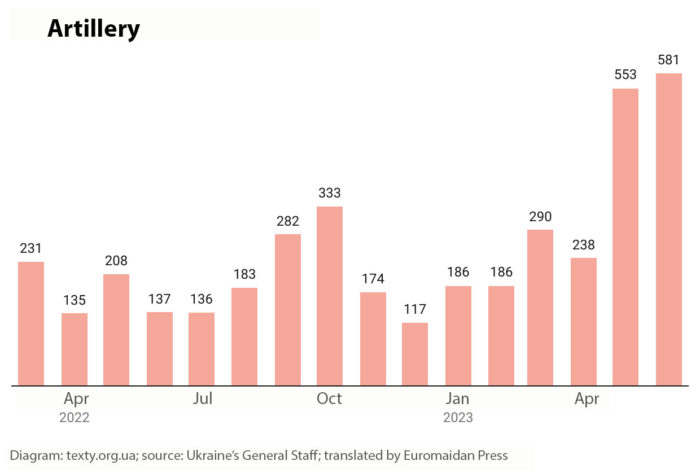
A similar trend is observed concerning automotive and supply vehicles.

In June (even though it is not yet over), the Ukrainian Army set a record for the destruction of Russian air defense equipment.

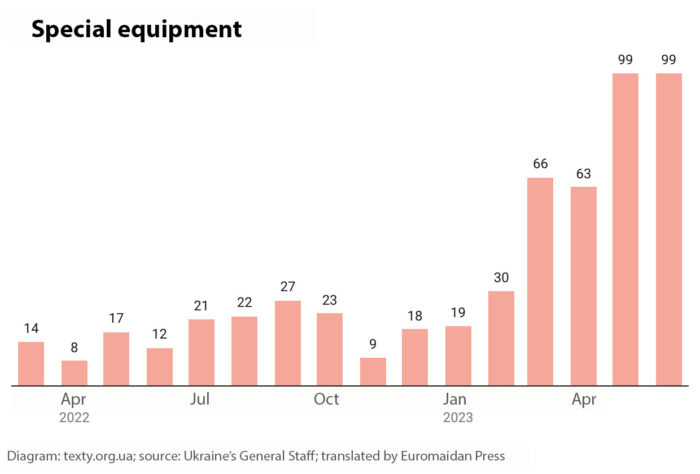
In May-June 2023, the Ukrainian Army systemically targeted and actively destroyed Russian special equipment. According to the General Staff of Ukraine's Armed Forces, this includes mobile command posts, drone control systems, electronic warfare, mine clearance systems, mobile pontoon systems, etc.
What is next?
According to the Ukrainian military leadership, Ukraine has not yet used its main forces in combat operations during the ongoing counteroffensive. According to Ukrainian and allied military experts, the Ukrainian Armed Forces have deployed less than a quarter of the troops trained for the counteroffensive.
Experts and journalists draw direct parallels between the operation to liberate Kherson last fall and the current counteroffensive (but on a larger scale). Indeed, in general, the logic of these operations is similar. However, the scale is very different. We should not expect a blitzkrieg from the Ukrainian Army, but we should not be disappointed either. The Kherson operation was prepared for several months and involved much fewer troops. During the Kherson offensive, bridges and ferries across the Dnipro River were within range of Ukrainian MLRS and artillery. Now the situation is quite different.
The Ukrainian Armed Forces are doing everything possible to liberate occupied territories from the Russian invaders. The Ukrainians need time and support as they risk their lives to defend democracy and freedom.
Related:
- Frontline report: Ukrainians reinforce assault group on eastern bank of occupied Kherson Oblast
- Ukraine makes incremental gains near Bakhmut for fourth consecutive day - Defense Ministry
- Ukraine advanced on at least two sectors of the front - ISW
- Strike on Chonhar bridge may disrupt Russian logistics in Zaporizhzhia Oblast
- Missile strike on Chonhar bridge causes delays in Russian military logistics - British Intel
- Evolution of Russian tactics in Ukraine
- Ukraine to liberate Crimea by end of August 2023 - Ben Hodges
- One year of Russia’s war: from battle of Kyiv to battle of Bakhmut
- Battle of Kyiv: tactics and tricks that saved Ukrainian capital
- Kherson residents share joy of being freed from Russian occupation
- How can Ukraine stop Russia?

